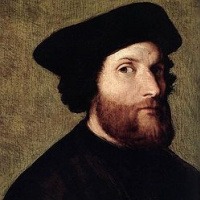Biography and information
Lorenzo Lotto was one of the best Venetian painters, apparently, a student of Giovanni Bellini (according to another assumption, a student of Alvise Vivarini), who later developed under the influence of Giorgione and partly Correggio. The artist was born about 1480 in Venice and died about 1556, probably in Loretto. In his talent, he combined the colouristic qualities typical for the Venetian school with the search for truth and beauty, with composition resourcefulness and a high poetic vein in general. He painted mainly religious paintings, but also portraits. His works are found in many Italian churches and art galleries. They are often met in the museums of England and Central Europe. The most remarkable of them are in the churches, such as S. Spirito (Mystic Marriage of St Catherine), S. Bernardino (Madonna Enthroned with Child, Angels, and Saints) and S. Bartolomeo e Stefano (The Martinengo Altarpiece) in Bergamo and S. Dominico (Assumption) in Ancona. There are three paintings by Lorenzo Lotto in the Imperial Hermitage: Madonna della Grazie, Rest on the Flight into Egypt with St Justine, and Portrait of an Old Man.
LOTTO, LORENZO (1480—1556) was a Venetian painter. He was born in 1480 in Venice and probably was a student of Alvise Vivarini. The artist took the traditional scheme of depicting subjects separately from their surroundings (the method overcome by Titian’s compositional unity) from Vivarini. Lotto largely developed Alevise Vivarini’s desire to convey subtle shades of moods and feelings. For this purpose, Lotto disturbed the balance of the figures in the composition; he did not consider it necessary to adhere to the modern style and overcome the alienation of the subjects from the world around them.
In 1526—1529 and 1540—1549, Lotto lived in Venice; however, he mainly worked in the provincial towns of northern Italy. The artist’s personal letters and documents show that he was a misanthrope and suffered from a lack of recognition. In his old age, he sheltered in Santa Casa in Loretto, where he died in 1556. Among his works are large traditional altarpieces, studies and sketches of individual figures of saints, as well as portraits. Several major works, such as a cycle of frescoes in the oratorio of the villa of Suardi in Trescora and intarsia carpets for wooden decoration in Basilica di Santa Maria Maggiore (Bergamo), reveal the unvarnished lively realism, unusual for any other artist of this time. From his early style, bright and somewhat ponderous (Portrait of Rossi; Annunciation altarpiece, 1528, Church of Santa Maria Sopra Mercanti in Recanati), Lotto moved on to the compositions full of stormy and vibrant movement (altarpiece of the Church of San Bernardino in Bergamo). Obviously, the Venetian tradition was the reason for the appearance of a softer and broader interpretation of nature (the numerous portraits speak for this). The later works of the artist are darker in colour, they feature more expressive and ambiguous surroundings (altarpieces in the Church of Santa Maria in Telusiano in Jesi, Monte San Giusto and in the Church of San Nicolo in Cignoli).
-
Artworks liked by35 users
- Artworks in 1 collection and 51 selections
-
Styles of artMannerism, Renaissance
-
TechniquesGouache, Oil, Chalk
-
Art formsPainting, Graphics
-
SubjectsStill life, Portrait, Nude, Religious scene, Mythological scene, Allegorical scene
-



